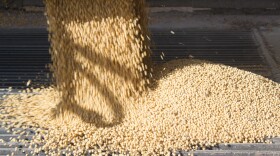Drew Eggers stood at the edge of one of his stubble fields when he plucked a patch of mint left over from harvest.
鈥淵ou can smell the spearmint,鈥� he said, offering it up for a sniff.
This was his 41st year farming out in Meridian, Idaho. It鈥檚 also his last.
鈥淭wo weeks ago, I had rented the farmland out to other farmers, and so we're starting retirement,鈥� he said.

He鈥檚 seen plenty of ups and downs with crops ranging from mint to corn to beans. His last year was pretty good. He attributes that to planning, saying, 鈥淵a know, a farmer anywhere needs to be a good business manager.鈥�
And it was a good year for a lot of Mountain West farmers. That鈥檚 even though the national ag economy is strained from a trade war with China. Part of the reason farmers here are doing well is because of what they grow and where they send it.
Carrie Litkowski is the farm income team lead with the U.S. Department of Agriculture鈥檚 Economic Research Service. She pointed to the region鈥檚 diversity of crops, saying it generally helps farmers weather price drops 鈥渂ecause then they aren't subject to, or they're not as vulnerable to price changes for a particular commodity.鈥�
While farmers in the Mountain West grow quite a few big crops, Midwest crop farmers tend to focus on just two: corn and soybeans. And soybean farmers took the biggest hit from the trade war because China was their biggest customer.
Then look at one of the main ag products in the West: beef. A major market for it is actually Japan. The Trump Administration originally pulled out of the Trans-Pacific Partnership, putting that market at risk, but gave beef breathing room there.
Dairy, Idaho鈥檚 largest ag product, depends more on markets in Canada and Mexico. It鈥檚 struggled through several rough years due to overproduction, but finally saw improvements due a slight drop in production this last year.
鈥淛ust recently, milk prices have gone above the break-even level to where our dairymen [are] starting to, you know, make back some of that money that they lost over the last four years,鈥� said Rick Naerebout, CEO of the Idaho Dairymen鈥檚 Association.
He said big dairies in Idaho also fared a bit better than smaller operations in the Midwest and East over the last few years, with fewer dairymen going out of business. The future is still hazy, though, like most of the ag sector right now.

鈥淚 hate trying to make any kind of forecast in the current political and trade environment,鈥� said Michael Nepveux, an economist with the American Farm Bureau. 鈥淚t's one of those things that can change with a single tweet."
Nepveux said that yes, Mountain West products are doing comparably well, depending on the metrics you look at. If you compare between the Mountain West and the Midwest, both look like they鈥檙e doing OK. But that data has a bit of a delay and Midwest farms are being with federal aid. Even with that financial help, Nepveux said the rate of farm bankruptcies is going up faster there.
Many Midwest farmers are also concerned that they鈥檒l lose Chinese markets in the long term as the country to get soybeans.
Still, Nepveux said farm debt across the nation is generally climbing more quickly than the value of what farmers own, 鈥渨hich means your debt-to-asset ratios are going what we would consider the wrong direction.鈥�
Then there鈥檚 the weather, which is also a bit of a crapshoot nationwide. Torrential rains and flooding hit already struggling Midwest farmers this year, and last year鈥檚 hurricane season wasn鈥檛 great for the Southeast. But here in the Mountain West, while there鈥檚 always the threat of drought, we had a pretty good year.
And that鈥檚 a big deal in Mountain West states where ag plays a major role in state economies.
Garth Taylor, a University of Idaho economist, compiles a yearly report on how ag is expected to do in the state. This last year, he thought Idaho farmers鈥� net incomes would keep slipping.
鈥淎nd when USDA put out their numbers in September, we found delightfully that we were wrong,鈥� he said.
Net incomes were nearly 90 percent higher than projected. And it wasn鈥檛 trade wars that threw him off: it was day-to-day costs. Prices for fuel and fertilizer turned out lower than expected, and in turn, farm operation costs did, too.
That鈥檚 all it took for the balance to shift between another down year and a regional resurgence. Find reporter Madelyn Beck on Twitter
Copyright 2019 Boise State Public Radio
This story was produced by the Mountain West 暗黑爆料 Bureau, a collaboration between Wyoming Public Media, Boise State Public Radio in Idaho, KUER in Salt Lake City, KUNR in Nevada, and KRCC and KUNC in Colorado.
Copyright 2020 Boise State Public Radio 暗黑爆料. To see more, visit . 9(MDAxNDQ2NDAxMDEyNzU2NzM2ODA3ZGI1ZA001))





